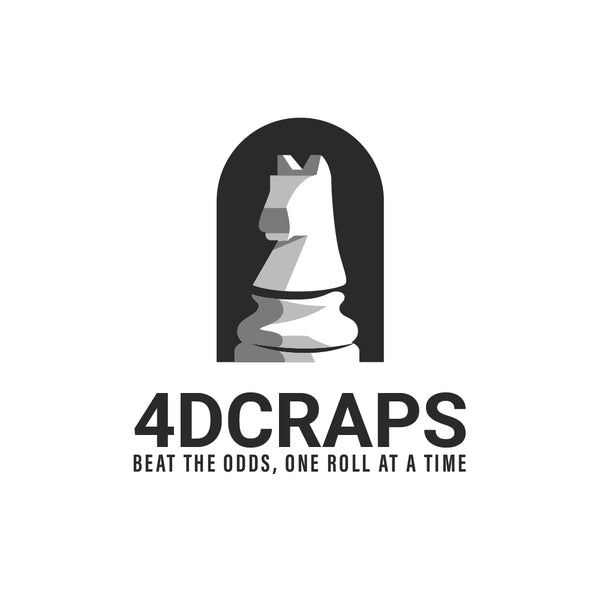🎲Can Craps Be Beaten? Challenging the Math with Strategic Discipline
Share
For decades, mathematicians, statisticians, and gaming experts have confidently stated one thing about craps: the game cannot be beaten over time. The claim is grounded in probability theory and the house edge built into every wager on the table. But is that the whole story?
This article explores the source of these claims, questions the assumptions behind them, and considers whether strategic, disciplined systems—like the 4D Craps Method—could shift the equation.
🧠 The Conventional Claim: “Craps Cannot Be Beaten”
Nearly all gaming literature, from casino guides to academic papers, states:
“Craps is a negative-expectation game. Every bet carries a house edge. Therefore, it cannot be beaten over time.”
These assertions are rooted in pure probability. Let’s take a look at why:
🔢 House Edge Examples
- Pass Line: ~1.41%
- Don’t Pass: ~1.36%
- Place 6/8: ~1.52%
- Hardways and Props: 6%–16%
So the logic goes: if every wager returns less than it risks, then no betting combination or pattern can create a long-term positive outcome. Fair enough—if you accept those conditions at face value.
But let’s ask a critical question...
❓ Do the Critics Consider All Forms of Strategic Play?
When most critics say craps can’t be beaten, what they often mean is:
- They've analyzed every possible combination of bets.
- All combinations yield a blended house edge that is still negative.
- Therefore, beating the game is mathematically impossible.
But what if that framework is too narrow?
⚠️ The Flawed Assumption:
Critics treat the craps table like a static matrix of bets, rather than a dynamic environment where a player can:
- Avoid high-edge bets entirely
- Engage only during certain roll windows
- Control volatility with flat betting
- Extract comp value
- And perhaps most importantly—play selectively
This isn’t about placing magic bets. It’s about timing, discipline, and edge minimization—something often overlooked in pure mathematical models.
🧠 A Historical Parallel: Edward Thorp & Blackjack
When mathematicians said blackjack couldn’t be beaten, a young MIT professor named Edward Thorp proved them wrong.
He showed that:
- While each individual hand was negative-expectation,
- The composition of the remaining deck changed those odds.
- By counting cards, he could shift the edge in his favor, especially when raising bets at favorable counts.
🎯 His system didn’t defy the math—it worked within the math to change his timing and exposure.
Likewise, blackjack’s basic strategy reduces the house edge to as low as 0.5%, giving skilled players greater control.
🔁 Can This Apply to Craps?
There’s no way to “count” dice or change their probability. But let’s consider:
- If blackjack can be reduced to near-breakeven with the right strategy…
- And edge-positive play combined with table comps can result in positive expected value...
- Then isn't it possible that craps—played with a refined system—could approach similar territory?
💡 The 4D Craps Method: A Strategy-Based Response
The 4D Craps Method is built not on “winning” in the conventional sense, but on:
- Flat betting to reduce variance
- Dynamic betting to turn odds in players favor
- Positional play—only betting during statistically stable roll windows
- Bankroll protection through disciplined exit points
- Comp exploitation—extracting monetary value from time at the table
These tactics, when combined, will turn craps into a +EV game by itself and when casino comps are added, will even add to the player's favor.
This is conceptually similar to:
- Card counting in blackjack
- Matched betting in sports wagering
- Advantage play in promotions or comps
⚖️ Reframing What “Beating Craps” Means
If we define “beating craps” as:
- Creating consistent long-term profits through manipulation of outcomes: ❌ Not possible without cheating.
- Gaining a mathematical edge through dice control: ⚠️ Unproven and controversial.
- Playing to overcome the house edge through strategy, discipline, and comp valuation: ✅ Possible with strict systems like 4D Craps.
🧾 Final Thoughts: Don’t Dismiss What You Haven’t Modeled
Those who say craps cannot be beaten often focus on bet structures, not player behavior or session strategy. Systems like the 4D Craps Method challenge the conventional belief—not by defying math, but by respecting it and working within its boundaries to control exposure, reduce risk, and add value.
In that sense, 4D Craps isn’t a loophole—it’s a reframing of how to think about success at the table.
For more info visit: https://www.4dcraps.com/
